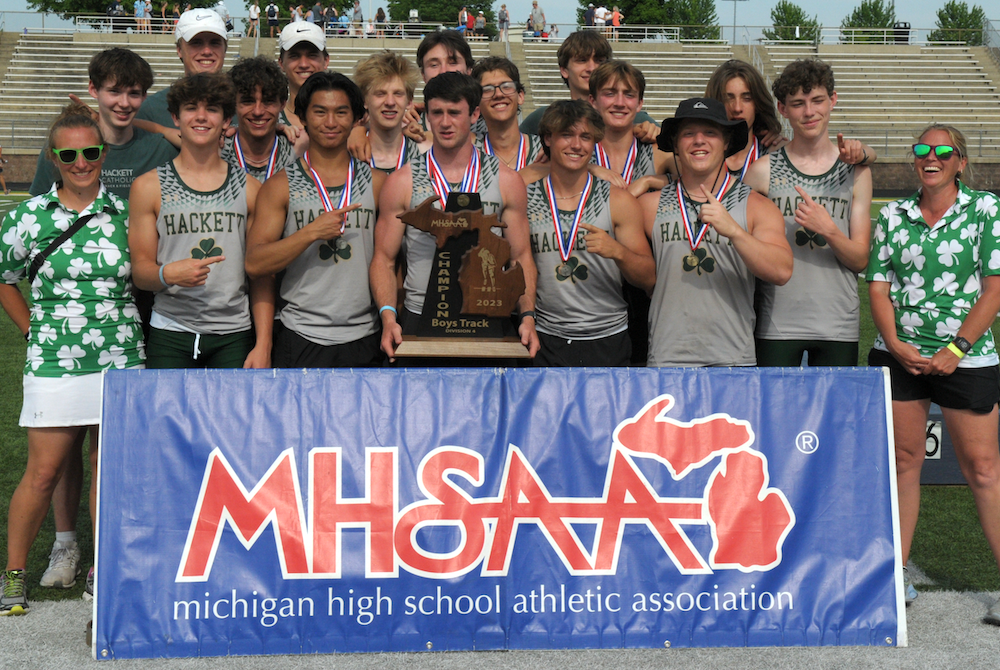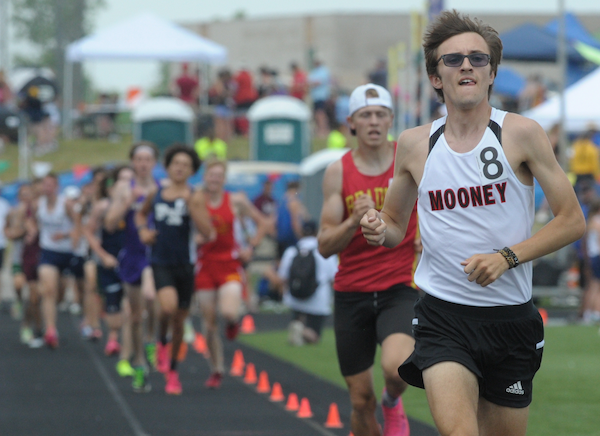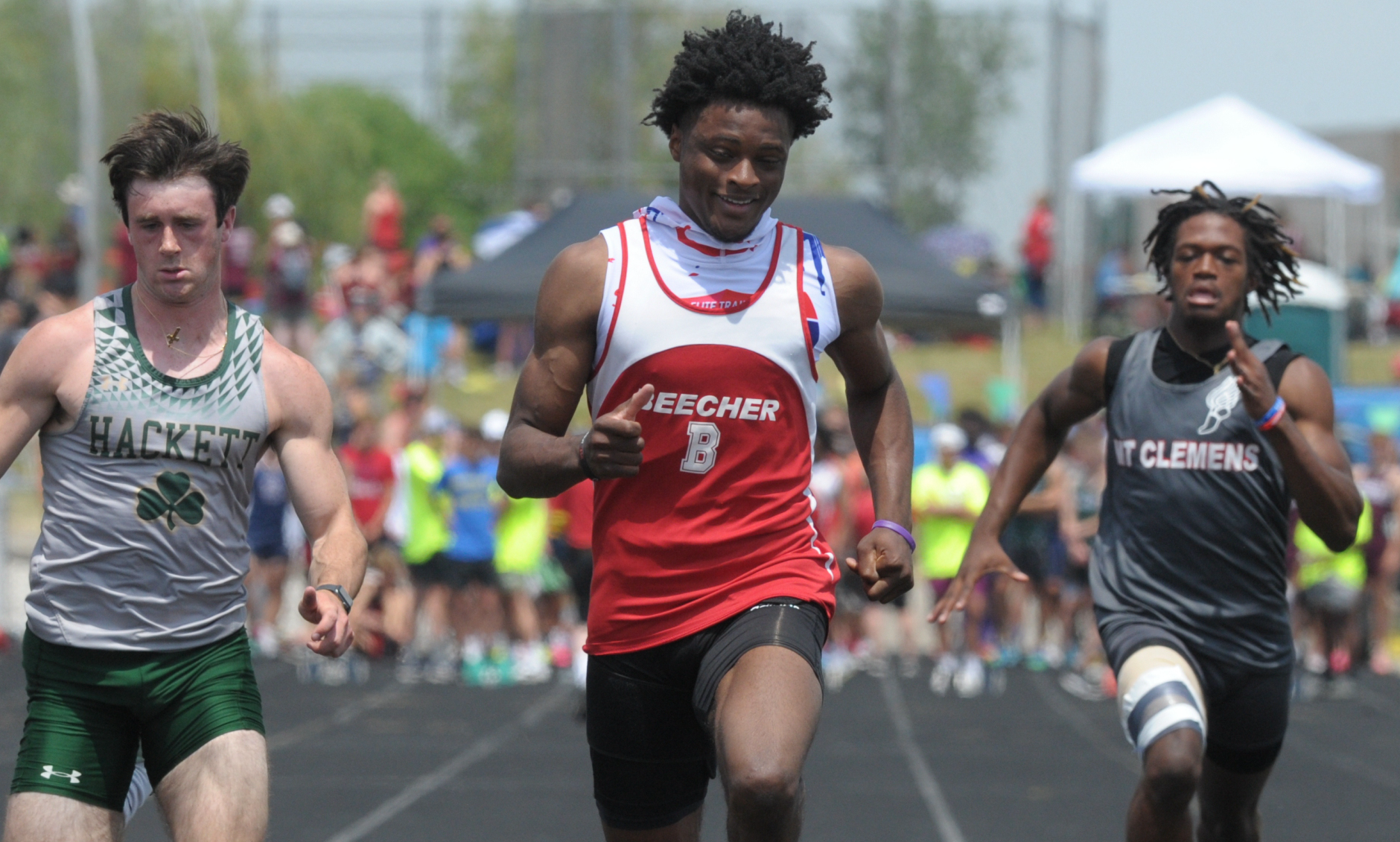
Team of the Month: Berrien Springs Boys Track & Field
By
Geoff Kimmerly
MHSAA.com senior editor
June 29, 2022
With two elite standouts comparable to the best pairs on any team statewide, and a deep group of sprinters capable of scoring major points, Berrien Springs track & field coach Johnathan Rodriguez had a feeling this could be a special spring for his boys team.
He scheduled tougher for that possibility, and planned everything pointing toward the Lower Peninsula Division 2 Final on June 4.
But Rodriguez didn’t breathe easily until that morning at Ada Forest Hills Eastern.
“I think the whole month, I think I was on pins and needles thinking of everything that could go wrong or wondering if we were ill-prepared or if we didn’t run them enough,” Rodriguez said. “And then we got to the meet that day, and they were just fresh and jumping around and happy, and we’re loose. They did very well.”
Berrien Springs – the MHSAA/Applebee’s “Team of the Month” for June – capped its season that day with its first MHSAA Finals boys track & field championship.
The title also was the first for the school in any sport since 2006, when the Shamrocks’ baseball team won the Division 3 title.
“We weren’t big on trying to win every meet. We were just thinking, all right, let’s try to be healthy for that state meet. So we were kind of smart in how we handled things and just scheduled things out so we can peek at the right moment,” Rodriquez said. “And I think it’s kind of a gamble that made us all uneasy, but they were just on fire that day.”
The boys track & field team had finished LP Division 3 runner-up in 2018, its highest Finals finish since coming in second in 1953. But with enrollment lines driving downward the last many years, Berrien Springs found itself it a much different spot beginning in 2021. The Shamrocks went from one of the largest schools in Division 3 to one of the smallest – the 11th-smallest of 155 teams this season – in Division 2.
Still, Berrien Springs received a strong indication it could compete with anybody this season when it ran at an invitational April 29 in Warsaw, Ind., against a number of larger Indiana schools include state power Carmel. Senior Jamal Hailey won the 100 and 200 meters, the 400 relay finished second, and senior James York was third in high jump as the Shamrocks hung with competition similar to the best they’d see in Michigan this spring.
Berrien Springs also possessed the right strengths to succeed in a championship format. The Shamrocks won their Regional by 37.5 points May 20 in part because the sprint group took nine top-eight places in the 100, 200 and 400 and won the 400 and 800 relays. The same formula worked as they won the Berrien-Cass-St. Joseph Conference championship meet the next week.
At the Finals at Forest Hills Eastern, Hailey won the 100 (10.77) and 200 (22.11) and York won the long jump (22-10). The 400 relay of senior Junyoung Chung, York, sophomore Jake Machiniak and Bailey won the 400 relay (42-44), and senior CJ Porter, Young, freshman Zander White and York placed eighth in the 800 relay (1:31.11). Freshman Noah Jarvis just missed scoring with a ninth place in the 400 (50.99).
With points spread out across several contenders, Berrien Springs’ 41 won the meet by eight.
Hailey finished the season undefeated in the 200 and with only one non-win in the 100, a runner-up finish at an early-season invitational. The 400 relay also was undefeated except for that second place in Indiana. York was undefeated in long jump except for finishing second in the Regional and league before coming back to win at the Finals. The 400 relay won every time he was a part.
Berrien Springs has had some recent success in other sports, particularly with Hailey leading a football team that went 10-1 last fall. This spring’s championship could be a catalyst for more Finals-level success in the near future across other sports.
“I hope so. I think that every kid that we had qualify (for the Finals) was a multi-sport athlete kid, and I think our 4x1(00) team, everybody on there was a three-sport athlete guy,” Rodriguez said. “Our athletic department works well, like our football guys lift with football two days a week and then come after track practice, so we have that nice working partnership with all the athletes.
“Now that we’ve shown that we can get there, I think it’s (shown) the kids at our school that hey, we can beat the bigger schools. We can hang. Track did it. Maybe we can do it next.”
Past Teams of the Month, 2021-22
May: Houghton boys golf - Read
April: Plainwell girls soccer - Read
March: West Bloomfield girls basketball - Read
February: Cadillac girls skiing - Read
January: Hartland hockey - Read
December: Midland Dow girls basketball - Read
November: Reese girls volleyball - Read
October: Birmingham Groves boys tennis - Read

Thrower Claims Lone Individual Title to Lead Hackett to Team 3-Peat
By
Tom Lang
Special for MHSAA.com
June 3, 2023
Kalamazoo Hackett Catholic Prep just keeps winning and winning.
This time the Irish took home their fourth title in the last five Lower Peninsula Division 4 Track & Field Finals, on Saturday at Hudsonville.
Hackett’s only individual title was taken by discus winner Nathan Buchmann, a senior, who was fine knowing he was the shortest in stature among all the sizable competitors.
“In the offseason after football I worked out every day, working towards this goal,” he said after getting his medal. “I would say this takes 80 percent technique and 20 percent strength to throw the discus. So, length can help but if you have good technique and are really strong, that will play into it.
“I think we are very balanced throughout the meet today,” he said about teammates that scored points in finishes other than first place. “We have 13 guys here today, and we have people in a lot of the races. But I do not run; I have too short of legs to be a fast runner,” he said with a chuckle.
Buchmann had to work through a hip injury to compete this spring.
“I think the setbacks are what make you strong,” he said. “You can either give up through the setbacks or push forward and become better.”
 Coach Charissa Dean agreed.
Coach Charissa Dean agreed.
“The kids have big hearts,” she said after all the points were totaled and the Irish were on top once again, with 53. “They worked hard. They had a lot of potential when we started the season. And we had a lot of drive to put in the work, and we are happy the results came out the way they did.”
Reading was runner-up at 47 points, followed by Wyoming Potter’s House Christian with 42, then Fowler and Flint Beecher each with 37 points.
Senior Lezawe “Moses” Osterink, of Potter’s House Christian, placed second in 1,600 but took the 3,200 title as defending champ of both. He dominated the latter by lapping the field with a final lap kick that resembled more of a superhero speedster.
“Nobody really took it out that hard at the start,” he said. “There was a freshman (Marek Butkiewicz of Hackett) that tried to get the pace going quick, but me and Dakota (Dykhuis of Montabella) just kind of sat back and gradually pulled him through.
“We took it gradually, and I was just relying that I could kick.”
Kick did he ever. The trio were neck and neck the majority of the race in a grouping ahead of the pack.
“With 400 to go I just tried to go all out,” Osterink said. “I had a lot more left than I thought and I was pleased with the win. Not really the time, but that doesn’t matter, especially this hot out.”
The overall meet was in the low 90s/high 80s heat and searing sun all day. So, race officials allowed the unique opportunity for coaches to spray the runners with water and give them water bottles.
“It was very weird because I’ve never taken water to drink while I’m running, so I didn’t know how that would feel,” Osterink said. “And they were spraying us and hitting us in the face. It was kind of fun.”
Junior Tyler Lenn of Marine City Cardinal Mooney defeated Osterink at his own game in the 1,600.
“I’m feeling great,” Lenn said after grabbing the medal. “I said to a newspaper after one of my races (during the season) I was right where I wanted to be. This has been a long rebuilding process for me since an injury back in the fall, and I set a pretty high goal the day the injury happened. I was telling myself I needed to fulfill what I said I would do at the beginning of last cross country season. And that is what I did today.”
Lenn suffered an ankle sprain from a misstep that turned worse because he kept running through the season on it.
“Coming back from that was pretty tough, but I wouldn’t have it any other way,” he said.  “Perseverance; I said from the beginning what I was going to do. I kept my eye on that target, and no matter the circumstances life threw at me, that I was going to make it happen and I am a man of my word.”
“Perseverance; I said from the beginning what I was going to do. I kept my eye on that target, and no matter the circumstances life threw at me, that I was going to make it happen and I am a man of my word.”
Jaylin Townsend, a senior from Flint Beecher, dominated the short races. He won the 100 dash (10.67) and 200 dash at 22 seconds flat. It was his third 100 win at a Finals.
“I put in a lot of work; I had to three-peat,” he said after the 100. “There’s a lot of great competition here, so I knew I had to come out and run my best.”
Concord in the 400 (43.72), Buckley in the 800 (1:30.76) and 1,600 (3:29.13) and Potter’s House in the 3,200 (8:14.18) were relay champs Saturday. Reading’s Tayshawn Bester won the 110 hurdles (15.13), and Athens’ Landen Bennett won the 300 (39.85). Caseville’s Nathan Feltner won the 400 (50.76), and Vestaburg’s Owen Patton claimed the 800 (1:55.11).
Fruitport Calvary Christian’s Bradley Richards won the high jump (6-10), and Peck’s Alex Affer won the long jump (23-4). McBain Northern Michigan Christian’s Isaac Bowden was first in pole vault (13-0), and Brown City’s Kyle Affer won shot put (49-2).
PHOTOS (Top) Kalamazoo Hackett Catholic Prep celebrates its third-straight LPD4 title Saturday. (Middle) Cardinal Mooney's Tyler Lenn, far right, sets the pace in the 1,600. (Below) Flint Beecher's Jaylin Townsend, middle, crosses the finish first for one of his two sprint championships. (Photos by Ken Swart/RunMichigan.com.)

